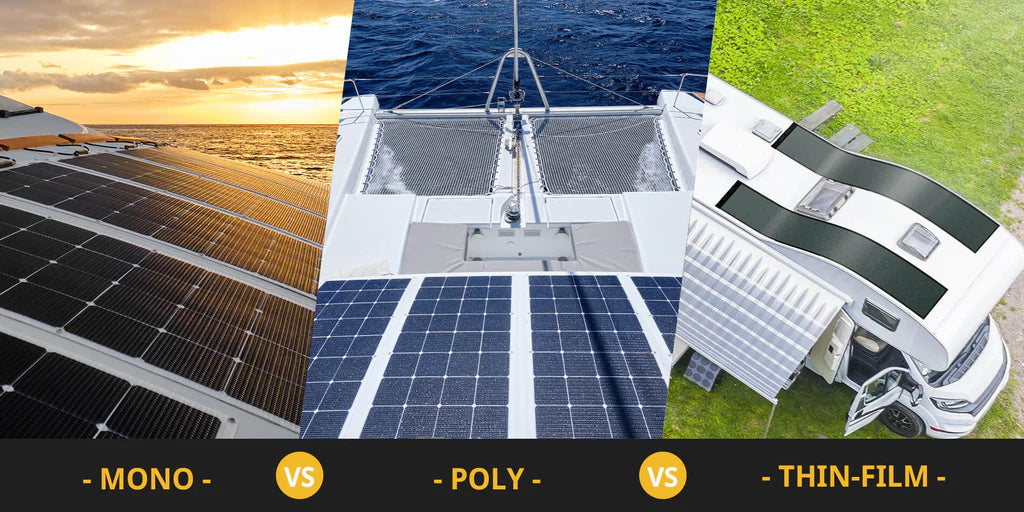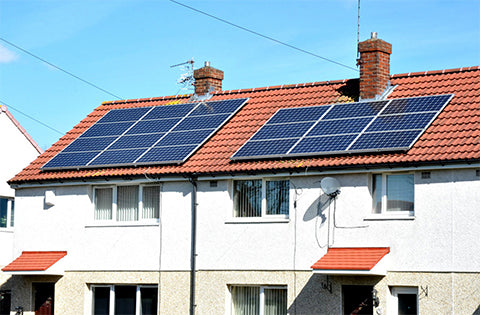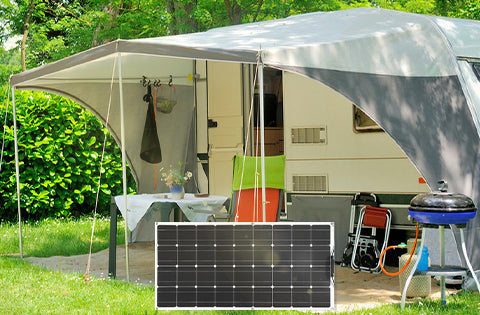When you pick an ideal solar panel, you might be confused and face the problem: which type of solar panel is suitable for your RV, camper, or roof? You have come to the right place. solarparts is here to help you sort through them! Understanding the difference between the three is the first step in choosing the perfect panel for your home, RV, or trip.

Types of solar panels
Monocrystalline, polycrystalline, and thin-film solar panels are the three most common types of solar receivers. The first two use photovoltaic cells made from silicon - the same material used for chips in electronics. The latter, on the other hand, is made up of amorphous silicon. Different types of material decide what you use them. A silicon one has higher efficiency, the amorphous silicon one has better flexibility.
Monocrystalline Solar Panels
Monocrystalline solar panels feature black photovoltaic cells with rounded edges. They have a higher conversion efficiency than polycrystalline panels, which means they can produce more kilowatt hours of electricity. If you want to install a solar panel system with limited space, then monocrystalline panels will be more productive per square foot.It is also the monocrystalline solar panels that are the most available on the market today.
Polycrystalline solar panels have straight-sided blue PV cells. They are less efficient than monocrystalline cells, which means you need more panels to achieve the same power output. However, polycrystalline panels are also less expensive because they are simpler to manufacture. Polycrystalline panels are durable but have a slightly shorter lifespan than monocrystalline panels. They are also more susceptible to high temperatures, reducing their productivity on the hottest days.
For users with more square footage and a smaller budget, polycrystalline is definitely the best choice.
Thin-film Solar Panels
CIGS Thin-film solar panels, also known as flexible solar panels, are made of one or more layers of thin-film materials that absorb light and generate electricity. Common types of thin films are: amorphous silicon, thin film silicon, cadmium telluride, copper indium gallium selenide, dye-sensitized solar cells (DSC), and other organic materials.
Compared to crystalline silicon solar panels, thin-film solar panels are more flexible and less affected by high temperatures, losing only a fraction of their performance when temperatures get too high.
In fact, all three types of solar panels have the same purpose: to convert sunlight into electricity. No matter which type of solar panel you have to choose in the end, remember the one you get can meet your need. We figured out there is many users who don’t find their ideal solar panels. We see our users' need for the uneven surface, so we made it.
How to Pick A Solar Panel
Although you may already know the difference between monocrystalline polycrystalline and thin film solar panels, you might not know what you should notice when buying them.
Efficiency
All PV panels have different efficiencies. This means that some types and even brands of solar panels can convert sunlight into electricity more efficiently than others. Typically, a monocrystalline solar panel can reach 15-25% efficiency. It's the most efficient solar panel on the market. Polycrystalline Solar Panels are usually between 15% and 17%, and the thin-film solar panel is generally between 10-13% in the market.
Thin-film solar panel has 16% solar cell efficiency. And the thin-film solar panel is ideal for curved structures where flat panel mounting is not feasible. Some off-grid and mobile applications also require thin films because of their lightweight. In addition, Solar panels are less affected by shadow shading due to their better weak light absorption conditions. This means that the efficiency of solar panels may be higher if they are in the same shadow-obscured environment.
Monocrystalline Solar Panel > Polycrystalline Solar Panel > Thin-film Solar Panel
Flexibility
If you are using solar panels for a more fixed location, such as on a roof, then a crystalline silicon solar panel with higher efficiency is certainly a better performer. But if you need a solar panel that can be placed on an uneven surface, such as a teardrop (because ordinary solar panels can't be placed on such a small flat surface), for this kind of thing, a thin-film solar panel that is more convenient to use is definitely a better choice. Not to mention, if you're a camping enthusiast, thin film solar panels fit nicely on the surface of your tent.
Thin-film Solar Panel > Monocrystalline Solar Panel = Polycrystalline Solar Panel
Cost
Monocrystalline panels are the most expensive of the three types of solar panels because of their manufacturing process and higher performance capabilities. Polycrystalline solar panels are slightly less costly than monocrystalline ones. Thin-film solar panels are the cheapest because they require less material and are less efficient.
But CIGS thin-film solar panels are thinner, more flexible, and more efficient than traditional monocrystalline panels in low-light areas. They are also easy to install and can have a lower profile than other solar system types, so the price is on the high side. We can say if you're looking for some solar devices to install on a yacht or small RVs. CIGS solar panel is definitely worth it, and it's the only and best choice for you.
Monocrystalline Solar Panel > Polycrystalline Solar Panel > Thin-film Solar Panel
Appearance
When buying the right solar panel, it is also important to consider the shape of the panel, but of course, if it is a better shape with the same great efficiency, it is even better.
Thin-film panels have a clean, all-black appearance. Monocrystalline panels have a solid black look and look stylish. The process of manufacturing polycrystalline solar cells gives the cells a blue marble appearance. This means each individual polycrystalline panel looks very different from the panel next.
Thin-film Solar Panel > Monocrystalline Solar Panel > Polycrystalline Solar Panel
Lifespan
It has to be said that monocrystalline solar panels last longer among the three types of solar panels. With usual maintenance, they generally last 25-40 years. Polycrystalline solar cells can last between 20-35 years. Thin-Film cells have the shortest lifespan of 10 to 20 years. Although Thin-Film panels have a short lifespan, they have the fastest payback time.
However, once the cell of monocrystalline solar panels and polycrystalline solar cells has been damaged, the efficiency will be reduced to a large degree. The thin-film solar panel can still perform well.
Monocrystalline Solar Panel > Polycrystalline Solar Panel > Thin-film Solar Panel
Conclusion
Monocrystalline and polycrystalline solar panels are the most common, but they are not the only types available. More options may feel confusing, but they will also allow your needs to be met more. If you want a good efficiency one, you might choose a monocrystalline solar panel. If you would rather like a convenient one and take-to-go, then the thin-film solar panel is your best choice.
After comparison, you can find what you're searching for at this whether you desire the more effective monocrystalline solar panels or the more transportable and practical thin-film solar panels.
FAQ
Which type of solar panel is Better: Mono, Poly, or thin-film?
Monocrystalline, polycrystalline, and thin-film solar panels have certain advantages and disadvantages, which means the better choice for you will depend on your specific project. Monocrystalline panels are recommended when space is limited and you are willing to make a more considerable investment to achieve maximum efficiency.
On the other hand, polycrystalline panels are recommended when you want to reduce upfront costs and have no space constraints. Or, thin-film solar panels are recommended if you are more inclined to try new technologies or are more accustomed to traveling outdoors. If you are still confused about choosing a suitable solar panel, you can contact us for help. We will offer a 1-on-1 service to help you get the ideal choice.
Is monocrystalline more expensive than polycrystalline?
Monocrystalline products are more expensive when comparing the prices of individual solar panels. When comparing quotations for whole solar systems, you may discover that the cost per kilowatt for both methods is identical. Because of its excellent efficiency, you will need to buy fewer single panels. Our monocrystalline solar panels can reach an efficiency of up to around 23%.
How are CIGS solar panels better than silicon solar panels?
CIGS solar panels are more sensitive to light and can absorb light sources more easily in low-light environments, enabling them to be less affected by shadows than crystalline silicon solar panels. At the same time, CIGS solar panels are more flexible and more applicable in mobile scenarios. Crystalline silicon solar panels are susceptible to microcracking, which can reduce efficiency and can catch fire in extreme cases, while CIGS solar panels are less affected.



